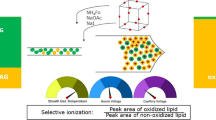Abstract
The current analytical method for the determination of fatty acids is by GC-FAMEs (gas chromatography-Fatty Acid Methyl Esters). GC-FAMEs consist of a time-consuming esterification process to increase the volatility and decrease the polarity of fatty acids before gas chromatographic separation. The work reported here evaluates ion mobility spectrometry as alternative method for the analysis of FAMEs. Electrospray ionization—ion mobility spectrometry (ESI-IMS) enabled the rapid qualitative analysis of both the non-volatile and volatile fatty acids (FAs) and FAMEs. For the volatile FAME compounds, a 63Ni ionization source was also evaluated. While individual analytes worked well, a mixture of the FAME analytes experienced ion suppression. Introduction of a FAME analyte mixture by electrospray-ionization improved both detection and separation. The introduction of the FAs by direct ESI with ion mobility separation, however, provided the best results producing a rapid method for the characterization of FAs that did not require derivatization. Reduced mobility values (K0) were reported for the first time for six FA analytes: heneicosanoic acid (1.03 ± 0.02 cm2V−1 s−1), cis-11-eicosenoic acid (1.07 ± 0.02 cm2V−1 s−1) oleic acid (1.13 ± 0.0 cm2V−1 s−1),cis-vaccenic acid (1.13 ± 0.02 cm2V−1 s−1), γ-linolenic acid (1.16 ± 0.02 cm2V−1 s−1), and lauric acid (1.31 ± 0.02 cm2V−1 s−1), as well as their corresponding FAME analytes: methyl heneicosanoate (0.90 ± 0.02 cm2V−1 s−1), methyl-cis-11-eicosenate (0.96 ± 0.02 cm2V−1 s−1), cis-11-vaccenic acid methyl ester (1.03 ± 0.02 cm2V−1 s−1), methyl oleate (1.05 ± 0.02 cm2V−1 s−1), methyl linolenate (1.12 ± 0.02 cm2V−1 s−1), methyl laurate (1.21 ± 0.02 cm2V−1 s−1).





Similar content being viewed by others
References
Christie WW (1993) Preparation of ester derivatives of fatty acids for chromatographic analysis. Adv Lipid Methodol: 69–111
Smedes F, Askland TK (1999) Revisiting the development of the bligh and dyer total lipid determination method. Mar Pollut Bull 38(3):193–201
Sawada H, Nogami C (2004) Capillary electrophoresis-electrospray ionization mass spectrometry using uncoated fused-silica capillaries and alkaline buffer solution for the analysis of small carboxylic acids. Anal Chim Acta 507:191–198
SF A. (1997) Handbook of instrumental techniques for analytical chemsitry
Dodd RS, Rafii ZA (1995) Ecogeographic variation in seed fatty acids of Austrocedrus chilensis. Biochem Syst Ecol 23:825–833
von Muhlen C, Marriott PJ (2011) Retention indices in comprehensive two-dimensional gas chromatography. Anal Bioanal Chem 401:2351–2360
Johnson DW (2000) Alkyldimethylaminoethyl ester iodides for improved analysis of fatty acids by electrospray ionization tandem mass spectrometry. Rapid Commun Mass Spectrom 14:2019–2024
Rustan AC, Drevon CA (2005) Fatty acids: Structures and properies. Encyclopedia of life sciences
Eiceman GA, Karpas Z (2005) Ion mobility spectrometry. CRC Press, Boca Raton
Bruins AP, Henion JD, Covey TR (1987) Ion spray interface for combined liquid chromatography/atmospheric pressure ionization mass spectrometry. vol 59. Analytical Chemistry
Davis EJ, Williams MD, Siems WF, Hill HHJ (2011) Voltage sweep ion mobility spectrometry. Anal Chem 83:1260–1267
Matz LM, Hill HH, Beegle LW, Kanik I (2002) Investigation of drift gas selectivity in high resolution ion mobility spectrometry with mass spectrometry detection. 13:300–307
Miller JM (2005) Chromatography: concepts and contrasts. Wiley, Hoboken
Harris DC Quantitative chemical analysis. W.H. Freeman and Company, New York
Jayalakshmi T, Santhakumaran A (2011) Statistical normalization and back propagation for classification. Int J Comput Theor Eng 3(1):1793–8201
Kanicky JR, Shah DO (2002) Effect of degree, type, and position of unsaturation on the pKa of long-chain fatty acids. J Colloid Interface Sci 256:201–207
Wu C, Siems WF, Asbury GR, Hill HH (1998) Electrospray ionization high-resolution ion mobility spectrometry-mass spectrometry. Anal Chem 70:4929–4938
Acknowledgments
The original suggestion that IMS analyses of FAMEs in the gas phase might be feasible was made by Mr. David Sickenberger, US Army Edgewood Chemical Biological Center, Aberdeen Proving Ground, MD.
Author information
Authors and Affiliations
Corresponding author
Additional information
Submitted to International Journal of Ion Mobility Spectrometry February 2015
Rights and permissions
About this article
Cite this article
Tufariello, J.A., Grows, K., Davis, E.J. et al. Rapid analysis of underivatized fatty acids by electrospray-ionization-ion mobility spectrometry. Int. J. Ion Mobil. Spec. 18, 95–104 (2015). https://doi.org/10.1007/s12127-015-0167-y
Received:
Accepted:
Published:
Issue Date:
DOI: https://doi.org/10.1007/s12127-015-0167-y




